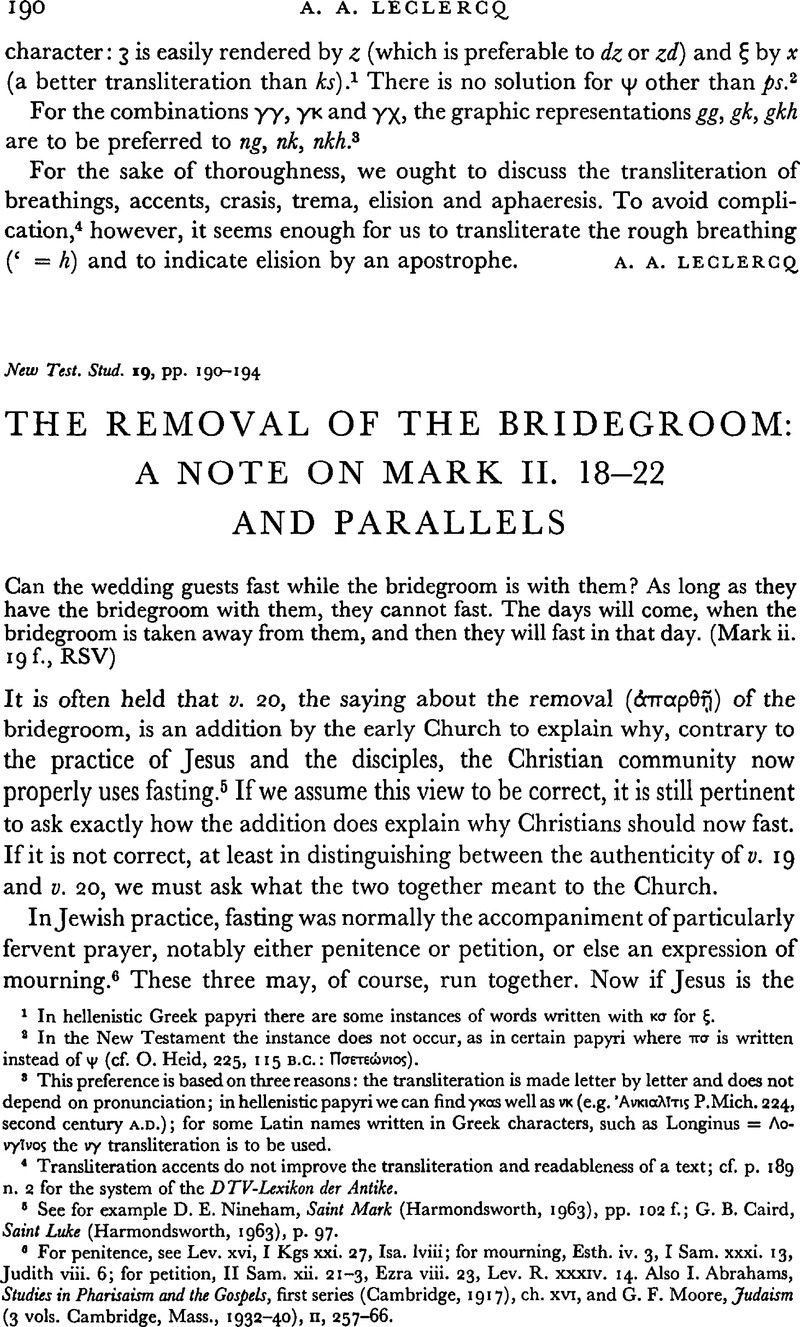No CrossRef data available.
Article contents
The Removal of the Bridegroom: A Note on Mark ii. 18–22 and Parallels
Published online by Cambridge University Press: 05 February 2009
Abstract

- Type
- Short Studies
- Information
- Copyright
- Copyright © Cambridge University Press 1973
References
page 190 note 5 See for example Nineham, D. E., Saint Mark (Harmondsworth, 1963), pp. 102 f.Google Scholar; Caird, G. B., Saint Luke (Harmondsworth, 1963), p. 97.Google Scholar
page 190 note 6 For penitence, see Lev. xvi. I Kgs xxi. 27, Isa. lviii; for mourning, Esth. iv. 3, I Sam. xxxi. 13, Judith viii. 6; for petition, II Sam. xii. 21–3, Ezra viii. 23, Lev. R. XXXIV. 14. Also Abrahams, I., Studies in Pharisaism and the Gospels, first series (Cambridge, 1917Google Scholar), ch. XVI, and Moore, G. F., Judaism (3 vols. Cambridge, Mass., 1932–1940), II, 257–66.Google Scholar
page 191 note 1 A recent account of the discussion on this matter is found in Kee, A., ‘The Question About Fasting,’ N.T. XI (1969), 161–73, pp. 165Google Scholar f. Jeremias, J., The Parables of Jesus, revised edn (London, 1963), p. 52Google Scholar n. 14, argues that depicting the Messiah as bridegroom was virtually unknown in Judaism before Paul. This is not decisive, however: the equation could have begun here as easily as in Paul, and while it would have seemed novel, it would not be incomprehensible.
page 191 note 2 E.g. O'Neill, J. D., ‘Abstinence, Catholic Encyclovpedia I: also the symposium, Christian Asceticism and Modern Man (London, 1955)Google Scholar by L. Bouyer and others, editor not named, pp. 4 f.
page 191 note 3 Der Evangelist Markus (Göttingen, 1956)Google Scholar.
page 192 note 1 Cf. Taylor, V., The Gospel According to St Mark (London, 1952), pp. 211 f.Google Scholar; Dunkerley, R., ‘The Bridegroom Passage,’ E.T. LXIV (1952–1953), 303–4Google Scholar, thinks Jesus speaks of his forcible departure as a live possibility, though not a certainty.
page 193 note 1 See for example Trilling, W., Das wahre Israel (Leipzig, 1959), especially pp. 196–200Google Scholar, and the recent article by Tagawa, K., ‘People and Community in the Gospel of Matthew,’ N.T.S. XVI (1970), 149–62.Google Scholar
page 193 note 2 Kee, art. cit. pp. 166–73, gives a discussion of the provenance. He thinks vv. 19–20 are a unit, but are not dominical, and do not answer the question about fasting. He thinks this is the Church's attempt to justify its fasting, but does not take account of the difficulty in the way of such a view, i.e. the absence of the Bridegroom. He also thinks that the juxtaposition of the bridegroom passage with the parables of the coat and the wine has been unfortunate for the interpretation of all three.
page 194 note 1 Cf. Davies, W. D., The Setting of the Sermon on the Mount (Cambridge, 1964), pp. 291–2.Google Scholar
page 194 note 2 I have not been able to consult Cremer, F. G., Die Fastenansage Jesu. Mk 2, 20 und ParallelenGoogle Scholar, who apparently considers that this saying (Mark ii. 20 and parallels) did not at first play any important role in the Church's justification of fasting, though it did later. This tends to support the interpretation offered above. See also his ‘Die Söhne des Brautgemachs (Mk 2, 19 parr) in der griechischen und lateinischen Schrifterklärung’, Bib. Zeit. XI (1967), 246–53.Google Scholar




